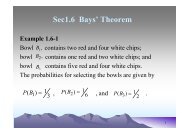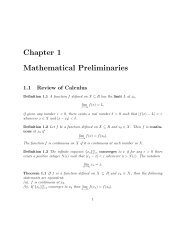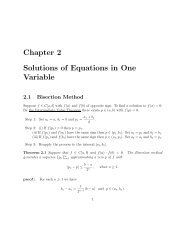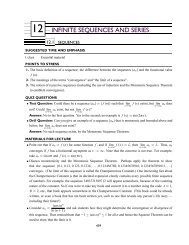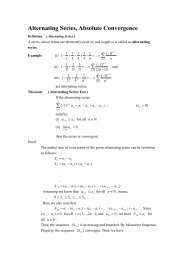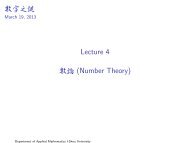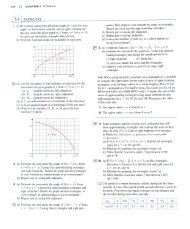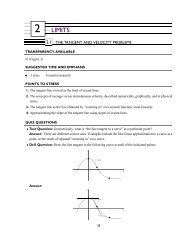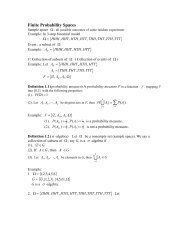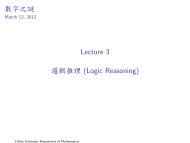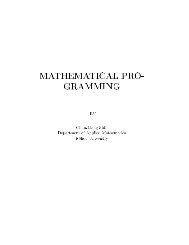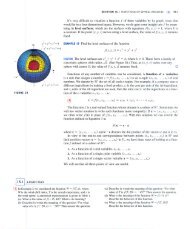[ill x = j .JY (y - 3),
[ill x = j .JY (y - 3),
[ill x = j .JY (y - 3),
You also want an ePaper? Increase the reach of your titles
YUMPU automatically turns print PDFs into web optimized ePapers that Google loves.
=================================================1 P f\. 0 a U 1'1S<br />
r-------<br />
I<br />
I<br />
I<br />
I<br />
I<br />
I<br />
-rL<br />
J _<br />
6. The figure shows a semicircle with radius 1, horizontal diameter PQ, and tangent lines at P<br />
and Q. At what height above the diameter should the horizontal line be placed so as to minimize<br />
the shaded area?<br />
7. Let P be a pyramid with a square base of side 2b and suppose that S is a sphere with its center<br />
on the base of P and S is tangent to all eight edges of P. Find the height of P. Then find the<br />
volume of the intersection of Sand P.<br />
8. Consider a flat metal plate to be placed vertically under water with its top 2 m below the<br />
surface of the water. Determine a shape for the plate so that if the plate is divided into any<br />
number of horizontal strips of equal height, the hydrostatic force on each strip is the same.<br />
9. A uniform disk with radius 1 m is to be cut by a line so that the center of mass of the smaller<br />
piece lies halfway along a radius. How close to the center of the disk should the cut be made?<br />
(Express your answer correct to two decimal places.)<br />
10. A triangle with area 30 cm 2 is cut from a corner of a square with side 10 cm, as shown in the<br />
figure. If the centroid of the remaining region is 4 cm from the right side of the square, how<br />
far is it from the bottom of the square?<br />
II. In a famous 18th-century problem, known as Buffon's needle problem, a needle of length h is<br />
dropped onto a flat surface (for example, a table) on w<strong>ill</strong>ch parallel lines L units apart, L :;;.h,<br />
have been drawn. The problem is to determine the probability that the needle w<strong>ill</strong> come to rest<br />
intersecting one of the lines. Assume that the lines run east-west, parallel to the x-axis in a<br />
rectangular coordinate system (as in the figure). Let y be the distance from the "southern" end<br />
of the needle to the nearest line to the north. (If the needle's southern end lies on a line, let<br />
y = O. If the needle happens to lie east-west, let the "western" end be the "southern" end.) Let<br />
e be the angle that the needle makes with a ray extending eastward from the "southern" end.<br />
Then 0 ~ y ~ Land 0 ~ e ~ 'fT. Note that the needle intersects one of the lines only when<br />
y < h sin e. The total set of possibilities for the needle can be identified with the rectangular<br />
region 0 ~ y ~ L, 0 ~ e ~ 'fT, and the proportion of times that the needle intersects a line is<br />
the ratio<br />
area under y = h sin e<br />
area of rectangle<br />
This ratio is the probability that the needle intersects a line. Find the probability that the<br />
needle w<strong>ill</strong> intersect a line if h = L. What if h = 4 L?<br />
12. If the needle in Problem 11 has length h > L, it's possible for the needle to intersect more<br />
than one line.<br />
(a) If L = 4, find the probability that a needle of length 7 w<strong>ill</strong> intersect at least one line.<br />
[Hint: Proceed as in Problem II. Define y as before; then the total set of possibilities for<br />
the needle can be identified with the same rectangular region 0 ~ y ~ L, 0 ~ e ~ 'fT.<br />
What portion of the rectangle corresponds to the needle intersecting a line?]<br />
(b) If L = 4, find the probability that a needle of length 7 w<strong>ill</strong> intersect two lines.<br />
(c) If 2L < h ~ 3L, find a general formula for the probability that the needle intersects<br />
three lines.



